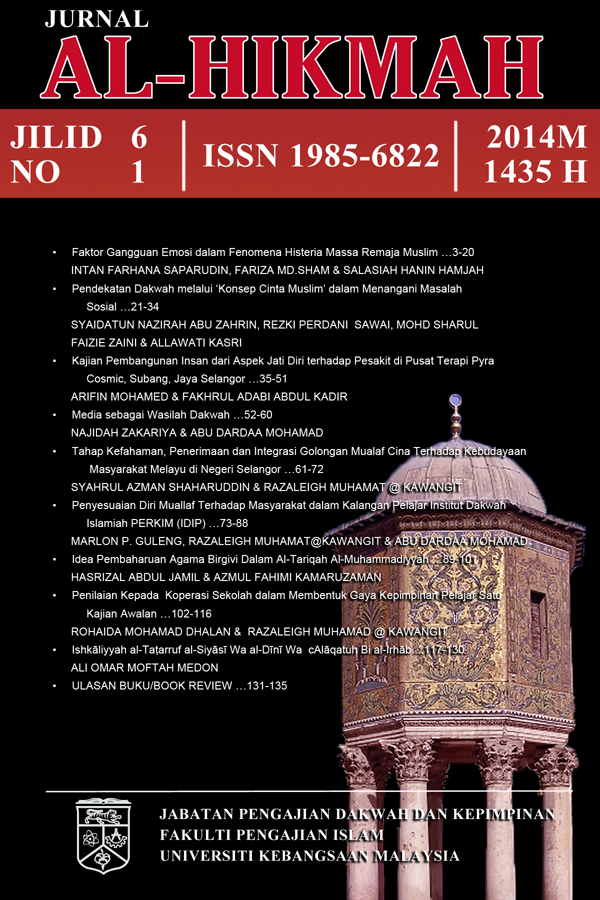FACTORS OF EMOTIONAL DISTURBANCE IN THE PHENOMENON OF MASS HYSTERIA AMONG MUSLIM ADOLESCENTS
Faktor Gangguan Emosi dalam Fenomena Histeria Massa Remaja Muslim
Abstract
The phenomenon of mass hysteria is a longstanding social issue in Malaysia. Mass hysteria mostly occurs in school communities, dormitories, and factories. In Malaysia, this phenomenon is more frequently observed among Muslim adolescents in schools. The impact of mass hysteria results in various negative effects, especially on emotions and social harmony. The epidemic causes a panic and tense atmosphere, disrupting the course of school activities. Therefore, this study aims to identify the factors of emotional disturbance in the phenomenon of mass hysteria among Muslim adolescents in schools. The study uses a survey method with questionnaires as the research tool. The sample consists of 105 students who have experienced hysteria from several schools around the state of Selangor. The results show that mass hysteria incidents stem from moderate to high levels of stress and emotional disturbance, leading to hysterical behavior outbursts. The symptoms of hysteria exhibited reflect elements of confusion and disturbance in affective functioning. Additionally, the study has identified several types of emotional disturbances that can trigger the hysteria epidemic among Muslim adolescents, including guilt over past mistakes, pent-up feelings, imagining frightening scenarios, sadness, anxiety, stress, panic, and fear. The implications of this study can help schools address mass hysteria by identifying these emotional disturbance factors.
References
American Psychological Association. 2009. APA Concise Dictionary of Psychology. Washington DC
Amran Kasimin & Haron Din. 1990. Rawatan Gangguan Makhluk Halus Menurut al-Quran dan al-Sunnah. Cet. Ke-IV. Kuala Lumpur : Percetakan Watan Sdn. Bhd.
Amran Kasimin dan Zulkarnain Zakaria. 1994. Histeria : Pencegahan dan Rawatan: Kuala Lumpur: Dinie Publisher.
Anon. 2011. Kecoh pelajar histeria cuba cederakan guru. Berita Utusan, 26 Januari
Bali, Wahid Abdussalam. 1971. Wiqayah al-Insan Min al-Jin wa al-Shaitan. al-Qahirah: Maktabah al-Tabiin
Bartholomew R.E & Sirois, F. 1996. Epidemic hysteria in school: An international and historical overview. Educational Studies 22 (3): 285. http://search.ebscohost. Com. Diakses pada 16 Oktober 2012)
Bartholomew R.E & Wesseley, S. 2002. Protean nature of mass sociogenic illness : From possessed nuns to chemical and biological terrorism fears. The British Journal of Psychiatry. 180: 300-306. http://bjp. rcpsych.org/ (16 April 2012)
Al-Binkani, Abu Anas Majid. 2004. Sahih al-Tibb al-Nabawi. Amman: Dar al-Nafa’is
Boss, Leslie. P. 1997. Epidemic hysteria: A review of the published literature. Epidemiologic Reviews 19 (2).www.epirev .oxfordjournals .org. Diakses pada 1 March 2011)
Chen, Cheng-Sheng M.D; Yen, Cheng-Fang M.D; Lin, Hsiu-Fen M.D; Yang, Pingchen M.D. 2003. Mass hysteria and perceptions of the supernatural among adolescent girl students in Taiwan. The Journal of Nervous and Mental Disease 191 (2) : 122-123
Corsini, R.J (Ed.). 2005. Encyclopedia of Psychology. New York: Wiley
Dannielle. M. 2007. The role of psychological variables in mass hysteria. Tesis Master, University of Canterbury, New Zealand
Fariza Md. Sham, Siti Norlina Mohamed, Intan Farhana Saparudin, Salasiah Hanin Hamjah, Rozmi Ismail, Mohd Izhar Ariff Mohd Kashim. 2012. Faktor histeria dalam kalangan remaja sekolah. Jurnal Teknologi (Social Sciences) 59 : 21-27
Fariza Md Sham. 2005. Tekanan emosi remaja Islam. Jurnal Islamiyyat 27 (1) : 3-24
First, M.B. Frances, A & Pincus A.H 2004. DSM-IV-TR Guidebook. Washington, DC: American Psychiatric Publication
Kasmini Kassim. 1992. Psikiatri Kanak-Kanak. Kuala Lumpur: Dewan Bahasa dan Pustaka
Kendell R.E. 1982. A new look at hysteria. Dlm. Alec Roy (pnyt.). Hyteria, hlm. 28-36. New Delhi. John Wiley & Sons, Ltd
Loa Zavala, N. 2010. The expulsion of evil and its return : An unconscious fantasy associated with a case of mass hysteria in adolescents. The International Journal of Psychoanalysis 91 : 1157-1178
Ma’rof Redzuan, Haslinda Abdullah. 2004. Psikologi. Kuala Lumpur : Mac Graw Hill
Mahmood Nazar Mohamed. 2001. Pengantar Psikologi Satu Pengenalan Asas kepada Jiwa dan Tingkah laku Manusia. Kuala Lumpur : Dewan Bahasa dan Pustaka.
Najati, Muhammad Uthman. 1992. Al-Quran wa ‘Ilm al-Nafs. Beirut : Dar al-Syuruq
Ramli Hassan. 1991. Pengantar Psikiatri. Kuala Lumpur : Dewan Bahasa dan Pustaka.
Small, G.W & Nicholi. 1982. Mass hysteria among schoolchildren : Early loss as a predisposing factor. Archives of General Psychiatry 39 (6) : 721-724
Small, G.W; Propper M.W; Randolph, E.T; Eth S. 1991. Mass hysteria among student performers : Social relationship as a symptom predictor. The American Journal of Psychiatry 148 : 1200-1205
Small, G.W; Feinberg D.T; Steinberg, D; Collins, M.T. 1994. A sudden outbreak of illness suggestive of mass hysteria in school children. Arch Fam Med 3 : 711-716
Syed Hassan al-Mashoor & Raihanah Abdullah. 1993. Gangguan Mental. Kuala Lumpur: Penerbit Fajar Bakti Sdn.Bhd
Syeikh Abdussalam Bali. 2010. Merawat Kemasukan Jin dan Histeria. Terj. Mohd Sofwan Amrullah. Selangor: Pustaka Ilmi
Tan E.S. 1963. Epidemic hysteria. The Medical Journal of Malaya 23: 72-76
Teoh, J.I, Saesmalijah Soewondo & Myra Sidharta. 1975. Epidemic hysteria in Malaysian Schools: An illustrative episode. Psychiatry 38 : 258-268
Teoh, J.I 1975. Epidemic hysteria and social change : An outbreak in a lower secondary school in Malaysia. Singapore Medical Journal 16 (4) : 301-306
Uthman Najati. 1985. Al-Quran dan Ilmu Jiwa. Terj. Ahmad Rofi’ Usmani. Bandung : Penerbit Pusaka
© 2025 Al-Hikmah.
Copyright of the published article is vested in UKM Press, Universiti Kebangsaan Malaysia upon formal acceptance and completion of the copyright transfer agreement.
All articles are licensed under a Creative Commons Attribution–NonCommercial 4.0 International License (CC BY-NC 4.0), which permits non-commercial use, distribution and reproduction in any medium, provided the original work is properly cited.





